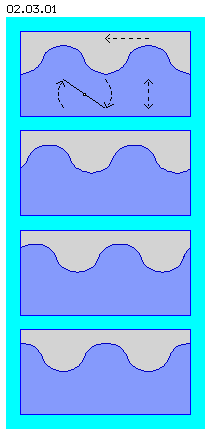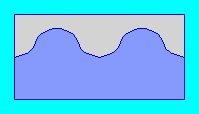Second well-known shape of waves is the circled spreading of waves at a water surface. This movement e.g. is started if a stone is thrown into the water. The water below of the stone is pressed downside, compensated by waters aside moving upwards. Upward directed stoke-movement also takes upward the neighbouring parts of water further outside (at larger distance to centre of waves).
 Based on gravity, afterward this hill of water falls down (deeper than the normal level of the water, based at its kinetic energy of the falling motion), thus again it´s moving up the waters aside of. The ring-shaped water-hills and -valleys thus wander outwards (radial to the wave centre). Based on friction within the water-medium, finally the differences of levels will decrease, i.e. the swinging motion will fade.
Based on gravity, afterward this hill of water falls down (deeper than the normal level of the water, based at its kinetic energy of the falling motion), thus again it´s moving up the waters aside of. The ring-shaped water-hills and -valleys thus wander outwards (radial to the wave centre). Based on friction within the water-medium, finally the differences of levels will decrease, i.e. the swinging motion will fade.
Characteristics of these cross-waves (respective transversal-waves) thus are, the parts swing cross (here up and down) to the spreading direction (radial outward from the centre). The motions up and down are accelerated and decelerated again between ´dead-points´ of movements.
Example water waves
Picture 02.03.01 schematically shows a section of a water tank with simplified marked waves at the surface. Right side of this picture, a wave motion could be initiated by the stone above. The wave (hill like valley) moves from right to left side (marked by arrow upside). Three more phases of motion are drawn below. The animation below visualizes this process by some moving pictures.
The movement cross to the spreading direction is marked by vertical double-arrow. If one valley and one hill is regarded same time, the motion could also be looked as a rocking motion (marked by up- and downward swinging seesaw).
No Dead Points within the Aether
These movements are well known by the mechanics of solid bodies and the water-particles here behave analogue to movements of solid bodies. Above this, transversal waves (e.g. Hertz-Waves of electro-magnetism) are a common shape of waves. However within the aether by itself, movements like these are impossible - because the aether don´t allow dead points.
All aether is in steady movement. As everything with anything is coherent, there can´t be any ´portion´ of aether without motion. In addition, there are no separated ´components´ of aether, that e.g. could do these abruptly changing of motion directions (change of up and down). Within the ether, only continuous movements are possible.
 At these water´s movements, indeed any motion is ´dead´ at upper and lower point. The motion is not finished in total, because the gravity is affecting, levelling potential energies of heights. These ´gravity-forces´ however, at the final end, lead to death of all movements - when waters rest silent again.
At these water´s movements, indeed any motion is ´dead´ at upper and lower point. The motion is not finished in total, because the gravity is affecting, levelling potential energies of heights. These ´gravity-forces´ however, at the final end, lead to death of all movements - when waters rest silent again.
No Heat-Death
The known considerations about the ´heat-death´ of the universe are quite consequent. Within the material word is nothing done without spreading- or friction-losses. So finally, all movements are levelled down to most low common level. So at the area of material world, indeed energy can be ´destroyed´ as opposite directed forces are resulting to null.
Opposite to that point of view, the universe appears really creative by steady production of diversified structures (and thus building up energy-differences). That´s a clear approval for the fact, the substance of the universe can not be build up by particles, but the aether must show properties quite opposite to these of the material world.
If the amount of energy within the universe should at least be constant, so this matter of fact can only be founded at ´unusual´ properties of the universe-wide aether. Only by it´s property of gap-less-ness, no single motion can ´get lost´ or can compensate to null.
. As within the aether nowhere a standstill can exist, within the aether no transversal waves (with periodic standstill) are possible (also not by additional turnings, see next chapter). ´Aether-Waves´ show much more complex shape (like discussed at further chapters).
| 02.04. No Circle, Straight Line, Torus | Aether-Physics and -Philosophy |